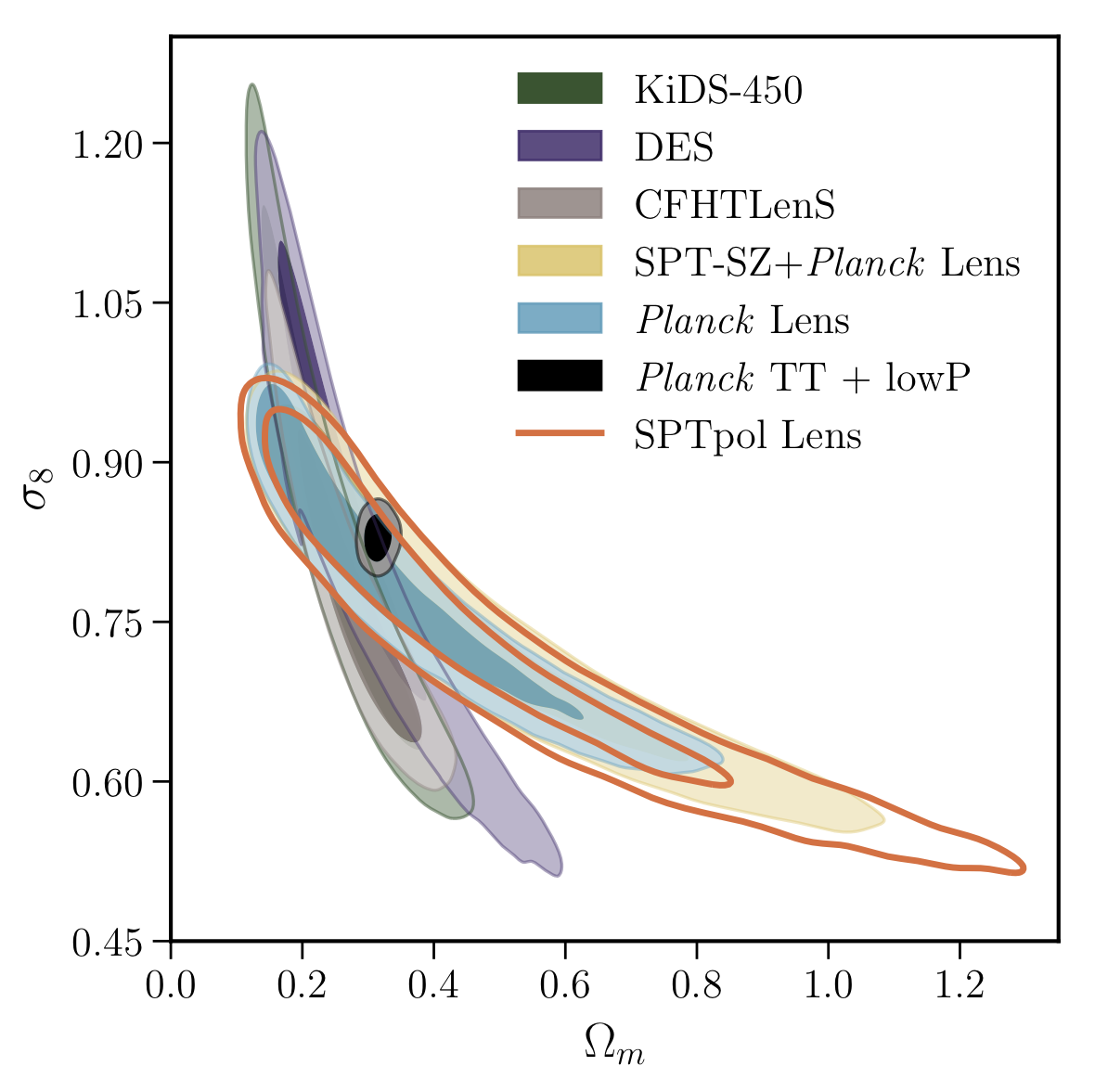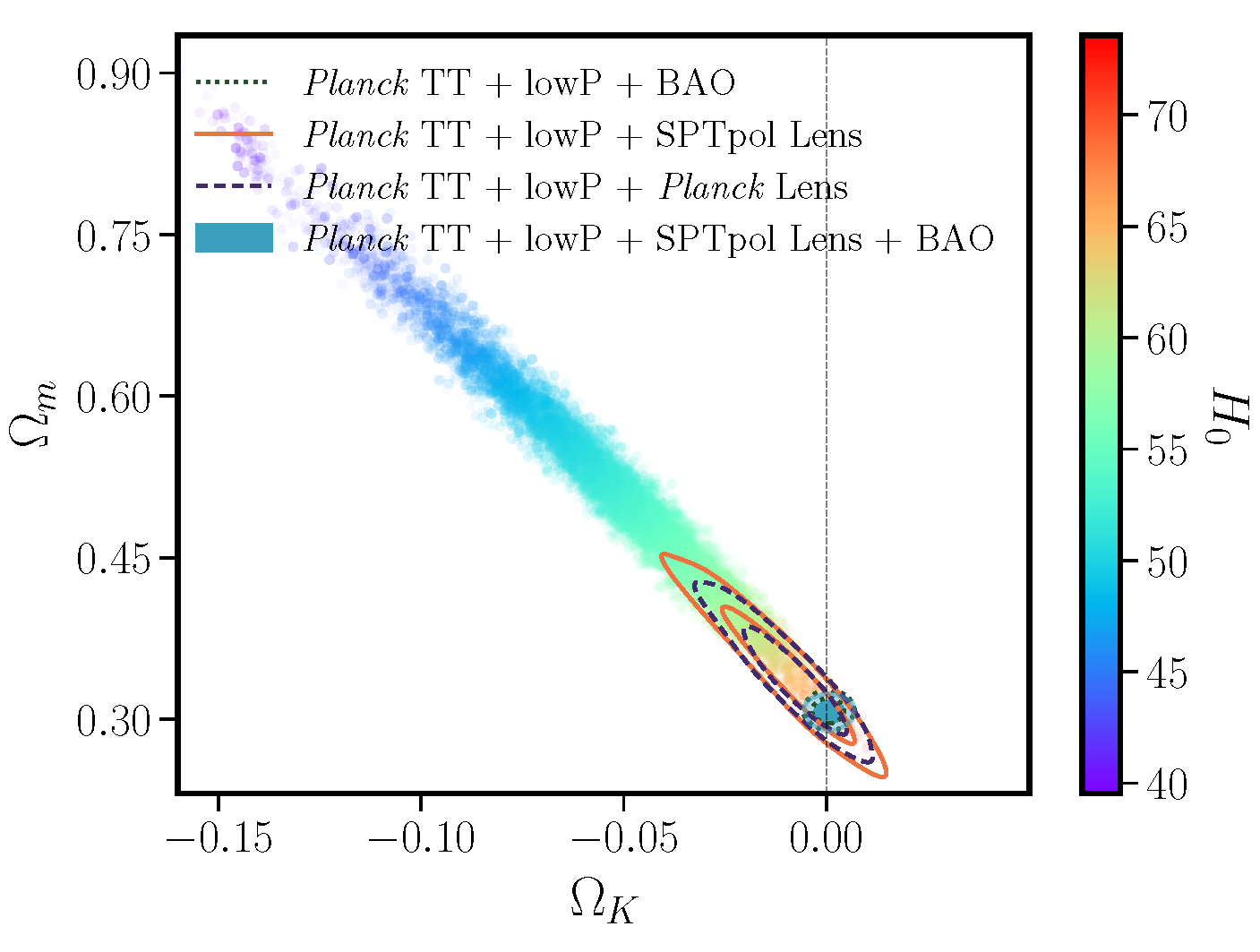|
Project Supported by
|
NSF, National Science Foundation
KICP, Kavli Institute for Cosmological Physics
USAP, United States Antarctic Program
Antarctic Support Contract
|
|
|
Related Websites
|
CBI, Cosmic Background Imager
DASI, Degree Angular Scale Interferometer
WMAP, Wilkinson Microwave Anisotropy Probe
|
|
|
|
 | Overview |
|
 |
|
| |
This page provides data products associated with the cosmological parameters analysis of the SPTpol CMB lensing power spectra over 500 square degrees described in Bianchini et al., (2019), based on results presented in Wu et al., (2019). The lensing band powers are presented over the multipole range 100 <= L <= 2000 and can be used to constrain cosmological models using the likelihood package provided below.
If you have any questions regarding this data set or its use, please contact Federico Bianchini (fbianchini_at_unimelb_dot_edu_dot_au).
|
| |
 | Figures |
|
 |
|
| |
Individual figures are available in PDF format here or bundled in a tarball here. We highlight some figures below.
|  The constraints on sigma_8 and Omega_m from CMB lensing (SPTpol, Planck, SPT-SZ +Planck) and optical lensing (KiDS-450, CFHTLenS, DES) surveys appear to be broadly consistent with each other. The different degeneracy direction between CMB and optical lensing surveys reflects their different redshift sensitivity to matter fluctuations. The independent high-redshift constraints from Planck primary CMB power spectra, shown as black contours, are also in
agreement with the lower redshift CMB lensing measurements. (Figure 2 in Bianchini et al., 2019)
The constraints on sigma_8 and Omega_m from CMB lensing (SPTpol, Planck, SPT-SZ +Planck) and optical lensing (KiDS-450, CFHTLenS, DES) surveys appear to be broadly consistent with each other. The different degeneracy direction between CMB and optical lensing surveys reflects their different redshift sensitivity to matter fluctuations. The independent high-redshift constraints from Planck primary CMB power spectra, shown as black contours, are also in
agreement with the lower redshift CMB lensing measurements. (Figure 2 in Bianchini et al., 2019)
|
 Constraints on curvature and total matter density from primary CMB (scattered points color-coded by Hubble constant value). Closed universe models with high curvature are inconsistent with lensing measurements (solid red and dashed purple lines, SPTpol and Planck lensing respectively) and ruled out by BAO data (dotted green line). The joint analysis of Planck primary CMB, SPTpol lensing, and BAO is fully consistent with a at universe (blue shaded contour). (Figure 7 in Bianchini et al., 2019)
Constraints on curvature and total matter density from primary CMB (scattered points color-coded by Hubble constant value). Closed universe models with high curvature are inconsistent with lensing measurements (solid red and dashed purple lines, SPTpol and Planck lensing respectively) and ruled out by BAO data (dotted green line). The joint analysis of Planck primary CMB, SPTpol lensing, and BAO is fully consistent with a at universe (blue shaded contour). (Figure 7 in Bianchini et al., 2019)
|
| |
 | Bandpowers and maps |
|
 |
|
| |
Bandcenters, bandpowers, and bandpower errors for plotting are provided in a text file
here.
Bandpowers and uncertainties are given in [L_b(L_b + 1)]^2 /2/pi
units. Each row is one ell-bin. The columns are (1) bin number, (2)
L_min, (3) L_max, (4) center of bin, (5) estimated clpp bandpower, (6)
sigma on the estimated clpp bandpower, (7) lensing amplitude compared
to the Planck 2015 base_plikHM_TT_lowTEB_lensing cosmology.
These bandpowers are foreground subtracted, where the lensing
foreground model has been taken from van Engelen et al. (2014).
The map can be downloaded here.
The included map is a minimum-variance estimated convergence,
mean-field subtracted and analytic-response corrected, in real space and in Fourier space.
Please note that the simulation response correction is not applied.
The map is in azimuthal equal-area projection centered at (RA, dec) = (0, -59.0) with 1 arcminute pixel size.
Please contact Kimmy Wu (wlwu_at_kicp_uchicago_dot_edu) for questions regarding the generation and use of these data products.
>
v1.0: Oct 23, 2019 - Initial version released with arXiv replacement/ApJ publication.
|
| |
 | Likelihood Code |
|
 |
|
| |
We provide files in a zipped file here that can be added to the Jul19 version of CosmoMC to interface with the SPTpol 500d CMB lensing bandpowers introduced above. The CosmoMC dataset contains the foreground template removed lensing bandpowers, the corresponding lensing bandpowers covariance matrix and the lensing linear corrections. The appropriate batch files for running CMB lensing-only and CMB lensing + external data are provided as well. A simple README file provides details on where to place these files within a working CosmoMC environement. No recompilation of CosmoMC is required, as this likelihood uses a generic Gaussian likelihood structure existing within CosmoMC.
If you have any questions regarding the use of this likelihood, please contact Federico Bianchini (fbianchini_at_unimelb_dot_edu_dot_au).
v1.0: Oct 16, 2019 - Initial version released with arXiv submission.
|
| |
 | Chains |
|
 |
|
| |
Chains are coming soon!
|
| |
|
|